Danish Asta Nielsen was the first European film star, but the first diva of the silent cinema was an Italian actress, Lyda Borelli. Her ecstatic and aristocratic performance, mixing grand gesture with delicate small details, her elegant attire and her long blond hair caused a craze. In the 1910s girls dyed their hair, went on diets and strove to imitate her twisted postures. This phenomenon was described in Italy as Borellismo. Soon other Italian actresses like Francesca Bertini, Pina Menichelli and Rina de Liguoro also swept across the screen. Their film dramas of the 1910s and early 1920s were full of decadence and outrageous emotion, and they offered an extravaganza of costumes and gestures. Ivo Blom selected for EFSP 12 dazzling postcards of these divas who gave the early Italian cinema grandeur, sensuality and style.
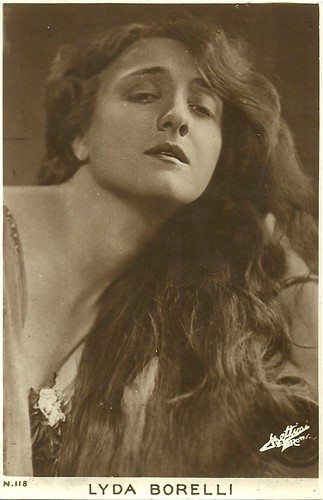
Italian postcard, no. 118. Photo Ed. Soc. Anon. It. Bettini, Roma.
Lyda Borelli (1887-1959) was already an acclaimed stage actress before she became the first diva of the Italian silent cinema. The fascinating film star caused a craze among female fans called 'Borellismo'.
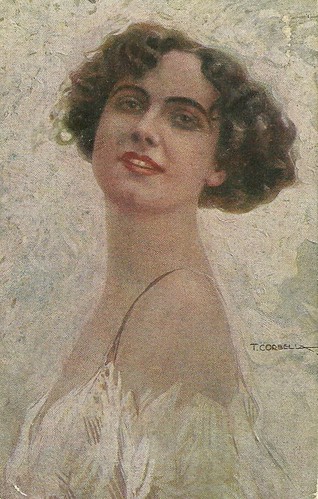
Italian postcard. Ufficio Rev. Stampa, no.894, Milano 25-5-1917. Portrait: Tito Corbella.
Francesca Bertini (1892-1985) had already a prolific career in one-, two- and three-reelers for the Italian companies Cines and Celio, before she received diva status in 1914. In 1921 she married count Paul Cartier and retired. After their divorce, she returned to the film sets. Her last film role was that of a nun in Bernardo Bertolucci's Novecento/1900 (1977).

Italian postcard by TM.
Fascinating and enigmatic Pina Menichelli (1890-1984) was the most bizarre Italian diva of the silent era. With her contorted postures and disdainful expression, she impersonated the striking femme fatale.

Italian postcard. Photo Ed. Emilio Sommariva, Milano, no. 1.
Polish actress Diana Karenne (1888-1940) was also one of the divas of Italian silent cinema. Between 1916 and 1920, Karenne fascinated audiences with her eccentric dresses and make-up, and with her primadonna behaviour. Afterwards she had a career in the German and French silent cinema.
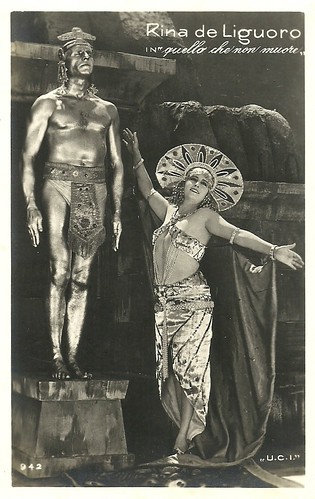
Italian postcard. U.C.I., no. 942. Rina De Liguoro in the Italian silent film Quello che non muore (Wladimiro De Liguoro, 1926).
Rina De Liguoro (1892-1966) was the last diva of the Italian silent cinema of the 1920s. She had her breakthrough in 1924 as the sensual, untamed Roman empress Messalina, and the beautiful countess continued her glittering career in such epics as Quo Vadis (1924), Casanova (1927) and Cecil B. De Mille's notorious Madam Satan (1930).

Italian postcard. Photo DM.
Polish singer and actress Helena Makowska aka Elena Makowska (1893-1964) was a beautiful diva of the Italian silent cinema in the 1910s. During the 1920s she moved to Berlin and also became a star of the German cinema.
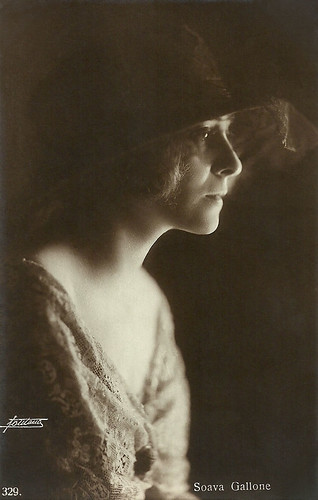
Italian postcard by Ed. A. Traldi, Milano, no. 329. Photo Fontana, Roma.
Polish actress Soava Gallone (1880-1957) was directed in one silent film after another by her husband, Carmine Gallone. From the mid-1910s onwards, the diva starred in many Italian films as the 'femme fragile'.

Italian postcard by G.B. Falci, Milano, no. 154. Maria Jacobini with Carmela Bonicatti (Carmen Boni) in La preda (Guglielmo Zorzi, 1921).
Among the Italian divas, Maria Jacobini (1892-1944) was an island of serenity, as film historian Vittorio Martinelli expressed it. She was the personification of goodness, of simple love. Her weapon was her sweet and gracious smile. However, in some Italian and later also in German films, she could as well play the vivacious lady, the femme fatale, the comedienne, the hysterical victim, or the suffering mother or wife.
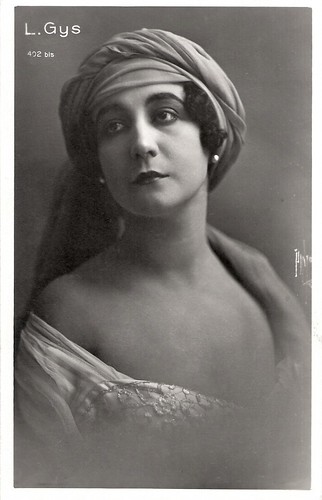
Italian postcard by Ed. Vettori, Bologna. Foto Pinto, Roma.
Versatile actress Leda Gys (1892-1957) was the only Italian diva who never played vamp roles and the only one whose career lasted until the advent of sound films. She starred in some 80 dramas, comedies, action thrillers and even westerns of the Italian and Spanish silent cinema. Her claim to fame came with the film Christus (1916), shot in Egypt and Palestine, where Gys performed the Madonna.

Italian postcard by Foto Ebano, no. 1.
Elena Sangro (1896-1969) was one of the main actresses of the Italian cinema of the 1920s. In spite of the general film crisis then, she made one film after another. She was also one of the first female directors and she had a famous affair with the 64-year-old poet Gabriele D'Annunzio.

Italian postcard by Ballerini & Fratini, Firenze, no. 529. Photo Scoffone. Italia Almirante in L'arzigogolo/The Court Jester (Mario Almirante, 1924), an adaptation of the play by Sem Benelli.
Italia Almirante (1890-1941) was one of the great divas of the Italian silent cinema. She starred in the classic epic Cabiria (1914). In the following decades she worked with some of the most important Italian directors of the silent era, including Roberto Roberti, Augusto Genina and Giovanni Pastrone. From 1935 on she played on stage in Brazil, where she suddenly died, when she was bitten by a poisonous insect.

Italian postcard by Ed. A. Traldi, Roma. Photo Pinto, Roma.
Hesperia (1885-1959) was one of the Italian divas of the silent screen. She often worked with director Baldassarre Negroni, who later became her husband.
This is a post for Postcard Friendship Friday, hosted by Beth at the The Best Hearts are Crunchy. You can visit her by clicking on the button below.

Source: Silents, Please!.

Italian postcard, no. 118. Photo Ed. Soc. Anon. It. Bettini, Roma.
Lyda Borelli (1887-1959) was already an acclaimed stage actress before she became the first diva of the Italian silent cinema. The fascinating film star caused a craze among female fans called 'Borellismo'.

Italian postcard. Ufficio Rev. Stampa, no.894, Milano 25-5-1917. Portrait: Tito Corbella.
Francesca Bertini (1892-1985) had already a prolific career in one-, two- and three-reelers for the Italian companies Cines and Celio, before she received diva status in 1914. In 1921 she married count Paul Cartier and retired. After their divorce, she returned to the film sets. Her last film role was that of a nun in Bernardo Bertolucci's Novecento/1900 (1977).

Italian postcard by TM.
Fascinating and enigmatic Pina Menichelli (1890-1984) was the most bizarre Italian diva of the silent era. With her contorted postures and disdainful expression, she impersonated the striking femme fatale.

Italian postcard. Photo Ed. Emilio Sommariva, Milano, no. 1.
Polish actress Diana Karenne (1888-1940) was also one of the divas of Italian silent cinema. Between 1916 and 1920, Karenne fascinated audiences with her eccentric dresses and make-up, and with her primadonna behaviour. Afterwards she had a career in the German and French silent cinema.

Italian postcard. U.C.I., no. 942. Rina De Liguoro in the Italian silent film Quello che non muore (Wladimiro De Liguoro, 1926).
Rina De Liguoro (1892-1966) was the last diva of the Italian silent cinema of the 1920s. She had her breakthrough in 1924 as the sensual, untamed Roman empress Messalina, and the beautiful countess continued her glittering career in such epics as Quo Vadis (1924), Casanova (1927) and Cecil B. De Mille's notorious Madam Satan (1930).

Italian postcard. Photo DM.
Polish singer and actress Helena Makowska aka Elena Makowska (1893-1964) was a beautiful diva of the Italian silent cinema in the 1910s. During the 1920s she moved to Berlin and also became a star of the German cinema.

Italian postcard by Ed. A. Traldi, Milano, no. 329. Photo Fontana, Roma.
Polish actress Soava Gallone (1880-1957) was directed in one silent film after another by her husband, Carmine Gallone. From the mid-1910s onwards, the diva starred in many Italian films as the 'femme fragile'.

Italian postcard by G.B. Falci, Milano, no. 154. Maria Jacobini with Carmela Bonicatti (Carmen Boni) in La preda (Guglielmo Zorzi, 1921).
Among the Italian divas, Maria Jacobini (1892-1944) was an island of serenity, as film historian Vittorio Martinelli expressed it. She was the personification of goodness, of simple love. Her weapon was her sweet and gracious smile. However, in some Italian and later also in German films, she could as well play the vivacious lady, the femme fatale, the comedienne, the hysterical victim, or the suffering mother or wife.

Italian postcard by Ed. Vettori, Bologna. Foto Pinto, Roma.
Versatile actress Leda Gys (1892-1957) was the only Italian diva who never played vamp roles and the only one whose career lasted until the advent of sound films. She starred in some 80 dramas, comedies, action thrillers and even westerns of the Italian and Spanish silent cinema. Her claim to fame came with the film Christus (1916), shot in Egypt and Palestine, where Gys performed the Madonna.

Italian postcard by Foto Ebano, no. 1.
Elena Sangro (1896-1969) was one of the main actresses of the Italian cinema of the 1920s. In spite of the general film crisis then, she made one film after another. She was also one of the first female directors and she had a famous affair with the 64-year-old poet Gabriele D'Annunzio.

Italian postcard by Ballerini & Fratini, Firenze, no. 529. Photo Scoffone. Italia Almirante in L'arzigogolo/The Court Jester (Mario Almirante, 1924), an adaptation of the play by Sem Benelli.
Italia Almirante (1890-1941) was one of the great divas of the Italian silent cinema. She starred in the classic epic Cabiria (1914). In the following decades she worked with some of the most important Italian directors of the silent era, including Roberto Roberti, Augusto Genina and Giovanni Pastrone. From 1935 on she played on stage in Brazil, where she suddenly died, when she was bitten by a poisonous insect.

Italian postcard by Ed. A. Traldi, Roma. Photo Pinto, Roma.
Hesperia (1885-1959) was one of the Italian divas of the silent screen. She often worked with director Baldassarre Negroni, who later became her husband.
This is a post for Postcard Friendship Friday, hosted by Beth at the The Best Hearts are Crunchy. You can visit her by clicking on the button below.

Source: Silents, Please!.
No comments:
Post a Comment